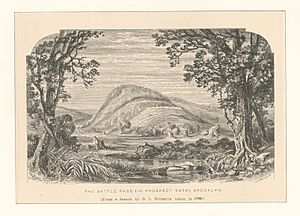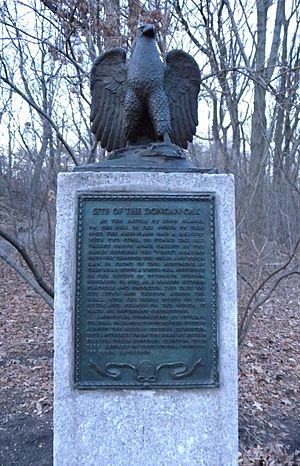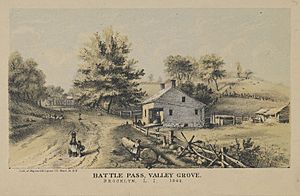Battle Pass facts for kids
Battle Pass is a historic area in Brooklyn, New York. It was once known by other names like Flatbush Pass or Valley Grove. This natural opening between hills was very important during the Battle of Long Island in 1776. Today, Battle Pass is a special part of Prospect Park.
Long ago, Flatbush Pass was a path through the Heights of Guan. This path followed an old Native American trail. Later, it became part of the original Flatbush Road. The pass was also a boundary line between the towns of Brooklyn and Flatbush. This boundary was set by the Dongan Charter on November 12, 1685. Even earlier, Governor Lovelace wrote about the pass in documents from 1670.
Contents
The Battle of Long Island
Battle Pass was the site of a fierce fight during the Battle of Long Island. This battle happened on August 27, 1776. American soldiers, led by General John Sullivan, fought against Hessian troops. The Hessians were German soldiers hired by the British. Their leader was Leopold Philip de Heister.
The Skirmish at Battle Pass
The Hessians had about 5,000 soldiers, while the Americans had only 1,300. The Americans had two cannons on a nearby hill called Redoubt Hill. One story says that a local farmer, Simon Voorhis, cut down a large tree called the Dongan Oak. He used it to block the path and slow down the enemy.
The fight at Battle Pass ended by late morning. General Sullivan was captured by the Hessians. The Hessian soldiers used a devastating bayonet charge to defeat the Americans. Many American soldiers died in this battle. Some were buried at the Flatbush Reformed Dutch Church Complex. For many years afterward, remains were still found in the area. Some Hessian soldiers who fought here even carved their names at the Wyckoff-Bennett Homestead.
Battle Pass in Prospect Park
The idea of saving the battlefield was a main reason for creating Prospect Park. Today, the pass stretches about 150 feet (45 meters) along the East Drive in the park. This part of the park is car-free.
The Dongan Oak Monument
Battle Pass is marked by a small monument called the Dongan Oak Monument. This monument remembers the large tree that marked the boundary. This tree was cut down and used as a barricade by American defenders. They used it to stop the British and Hessian invasion. The stump of the Dongan Oak was still there in the 1840s. It might have been removed when Prospect Park was built. Parts of the hills were also leveled during the park's creation.
A Vineyard and Park Design
In the early 1800s, a vineyard was planted at Battle Pass. It grew Isabella grapes. When Prospect Park was designed, the creators wanted it to look very natural. Because of this, they did not build a very large memorial at Battle Pass. So, many people today might not even notice the historic site.
Later Memorials and Markers
For the United States Centennial in 1876, a Line of Defense monument was put up. The Sons of the Revolution sponsored it. A Centennial Oak tree was also planted. In 1890, a new Dongan Oak was planted on Arbor Day. John W. Hunter planted it, and descendants of the Dongan family were there.
In the 1910s, Raymond Ingersoll placed temporary markers at Battle Pass. These markers also showed other Revolutionary War sites in the park. These markers are now lost. Charles M. Higgins wrote some of these markers. He also suggested building more detailed monuments for the Battle of Long Island. He even proposed placing Revolutionary War cannons on Redoubt Hill.
The Dongan Oak Monument, with its bronze eagle, was officially dedicated on Evacuation Day in 1922. Frederick Ruckstull designed it. The Saint Nicholas Society of the City of New York sponsored its creation. In 1929, the local "Battle Pass Chapter" of the Daughters of the American Revolution added another boulder marker.
The eagle on the Dongan Oak Monument has been stolen twice, once in the 1970s and again in the 1990s. Both times, the Prospect Park Alliance replaced it. The area around the monument has sometimes flooded. It was repaired in the 2010s to fix this problem. Two other historic stone tablets also mark Battle Pass.
|
See also
 In Spanish: Pase de batalla para niños
In Spanish: Pase de batalla para niños




